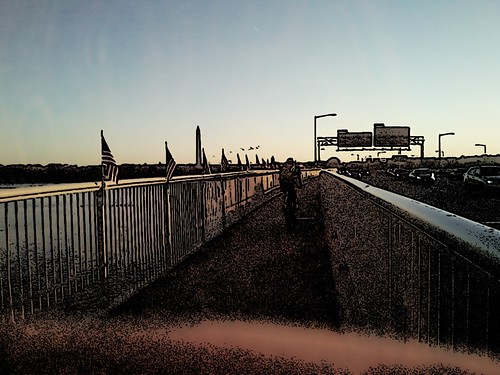
Flags on the bridge near the Pentagon
When the first diamond frame bicycles became popular in the 1890s they were often called "wheels" - the national cycling association was called the "League of American Wheelmen." We have moved from "wheels" to "bikes," but the bicycles have remained remarkably the same over more than 100 years - elegant in their efficiency and simplicity. And many of the issues that we think are new? They were around then too.
 Travels with Willie: Adventure Cyclist by Willie Weir
Travels with Willie: Adventure Cyclist by Willie Weir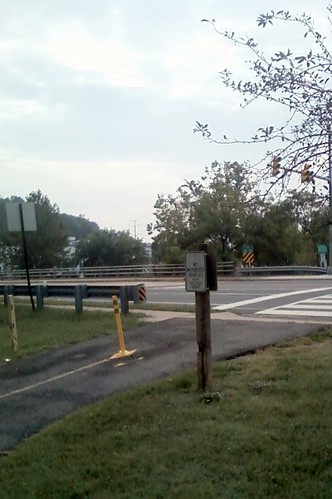

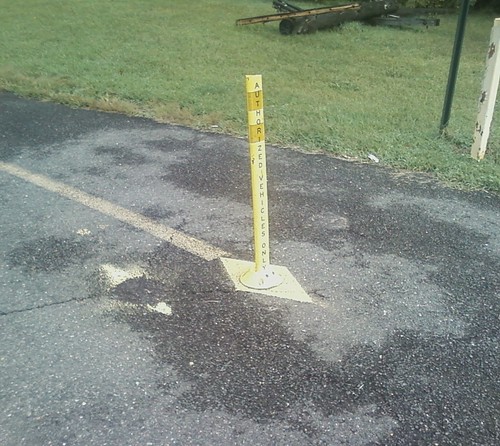
 Slaying the Badger: Greg LeMond, Bernard Hinault, and the Greatest Tour de France by Richard Moore
Slaying the Badger: Greg LeMond, Bernard Hinault, and the Greatest Tour de France by Richard MooreSource: gallica.bnf.fr via GallicaBnF on Pinterest
Source: gallica.bnf.fr via GallicaBnF on Pinterest

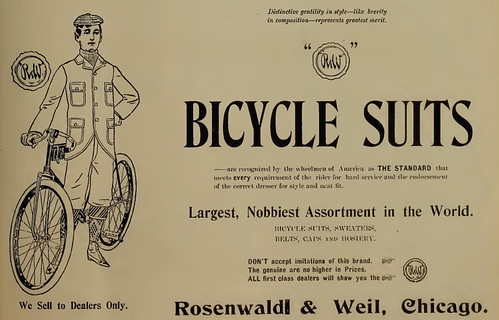
 100 Years Of Bicycle Component And Accessory Design: The Data Book (Cycling Resources) by Van Der Plas Publications
100 Years Of Bicycle Component And Accessory Design: The Data Book (Cycling Resources) by Van Der Plas Publications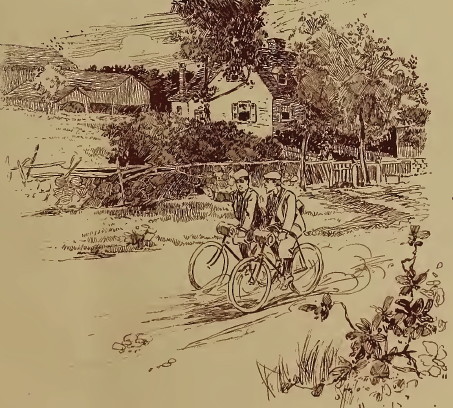
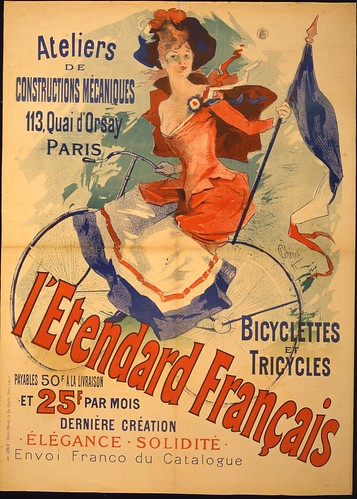

THE "WORLD" QUINT.
It is Exhibited on the Road and Track and Causes Astonishment.
The quint made by Arnold, Schwinn & Co., to be used in pacing Johnson, made its appearance last week and was given a trial at the Thirtyfifth street track. Kennedy made an attempt at Steele's state record of 1:55, but the track being in poor condition and the men not being used to the machine the best time made was 2:08. The chains on the machine were too tight to admit of its being ridden as fast as Kennedy was capable of going. The makers had figured on the chains stretching enough in riding the quint to the track to make them about right, but the chains didn't stretch. This fault was easily and quickly remedied, and the big affair was out on dress parade Sunday, the riders being clad in white suits. The boulevards were covered in the morning, a crowd of cyclists following at all times. The machine is a fine-looking affair, is substantial and ought to serve its purpose well. It has been shipped to the team in Paris.
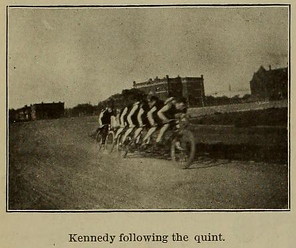
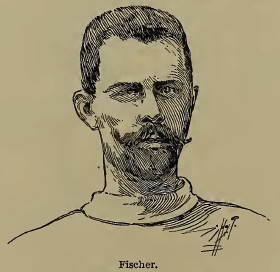
FISHER'S BIG ROAD RIDE.". . . Tenth [place prize] was a case of champagne . . . "
COVERS 174 MILES FROM PARIS TO ROUBAIX IN 9 HRS. 17 MIN.
Averages Over Eighteen and a Half Miles an Hour on the Journey—
Linton Holds Him Even for a Part of the Distance.—
Eck and Johnson's Plans
Paris, April 21.—[Special correspondence.]
Favored by glorious weather, the opening road event of the season, Paris to Roubaix, 280 kilometres, or 174 miles, duly took place last Sunday, forty-eight riders out of an entry of a hundred facing the starter at the Porte Maillot at 5:30 a. m. The value of the prizes was as under: first, £40, second, £20, third, £12, fourth, £8, the following five £4 each, and the tenth was a case of champagne. A prize of £6 was awarded the leading man at Amiens. A. V. Linton managed to secure this sum, winning by half a wheel from Fisher. All along the line road records were smothered, the winner Fisher, riding throughout the race at an average speed of over 18.2 miles an hour, which pace in itself constitutes a record for tourist riding.
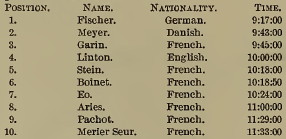
In the presence of over 10,000 people at the Roubaix track, Fischer, the German, wheeled six laps, having secured the first prize, and covered the full journey in the wonderful time of 9 hrs. 17 min.
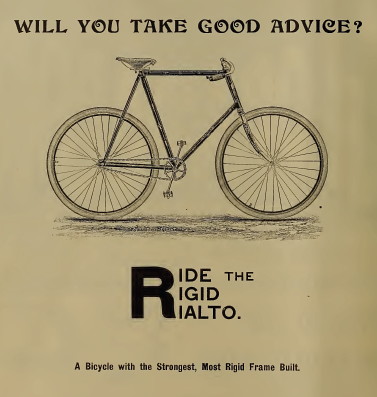
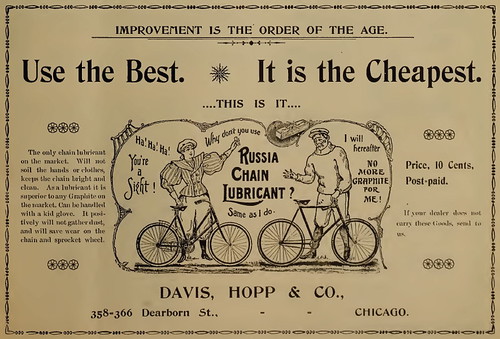
Russia Chain Lubricant Use the Best - It is the CheapestSo the main advantage of this product is that it goes on clean, unlike graphite. And then a bit of comparative advantage in lubrication is claimed too, why not.
Improvement is the order of the day
The only chain lubricrant on the market. Will not soil the hands or clothes, keeps the chain bright and clean. As a lubricant it is superior to any Graphite on the market. Can be handled with a kid glove. It positively will not gather dust, and will save wear on the chain and sprocket wheel.
"Ha ha, you're a sight! Why don't you use Russia Chain Lube, same as I do?"
"I will hereafter. No more graphite for me!"
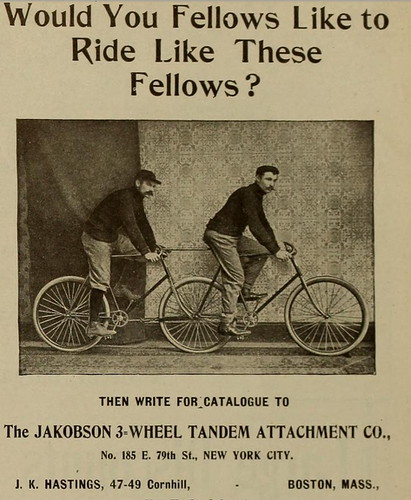

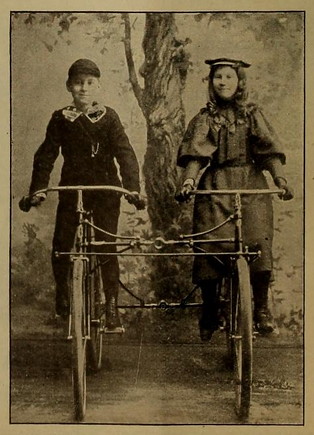
(What is meant by "Wheel Tax" would be a tax on bicycles - here, "wheel"="bicycle.")
WHEEL TAX LEGISLATION.
The solution of the financial problems associated with cycle path programmes by the imposition of a tax on all owners of bicycles within the districts affected is an easy but by no means always desirable one. There is strong opposition being manifested just now against a bill providing for such a tax which has been introduced into the New York legislature and in many other localities the proposition has been duplicated.
Only when a thorough canvass of the riding community reveals a practical unanimity of sentiment in favor of such a measure does it enter the field of reasonable and proper legislation. Falling short of this measure of endorsement by those whom it chiefly affects, it takes rank with the most vicious examples of unwarranted and discriminating law making.
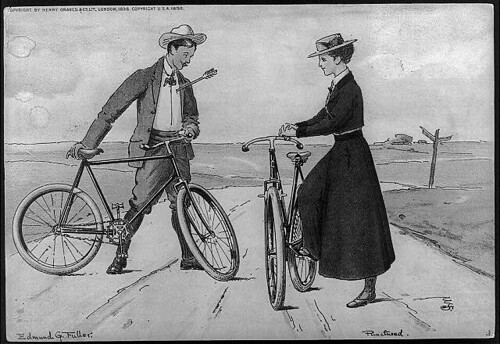
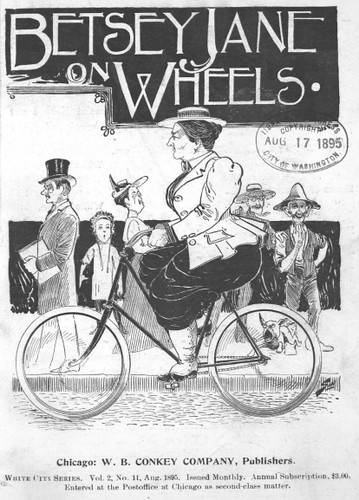
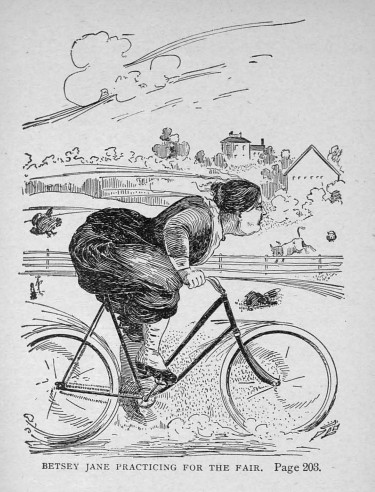
IN CONCLUSION.
As the most interesting part of a book is usually the conclusion I have concluded to finish this work by writing a conclusion, but will leave the reader to form his or her conclusion in regard to its merits.
I have attempted to give some idea of the bicycle craze which is now so prevalent, and although some cases may be slightly overdrawn, I think that I am justified in such overdrawing, as the bicycle craze will undoubtedly reach more alarming proportions another season.
The large manufacturers of buggies, wagons and street cars having noticed a decided falling off in the demand for their goods, and, profiting by this experience, have concluded to meet the popular demand by converting their plants in bicycle factories. They have declared their intention to place wheels on the market at less than one-half the present prices, which will bring them within the reach of nearly everyone. When a good wheel can be purchased for twenty-five or thirty dollars, few people will be without one, for as a means of conveyance the cycle eclipses all four-footed beasts, as it is cheaper, safer and faster.
That cycling is a healthy and profitable recreation, none can deny, but, like all other good things, there will be plenty of people who will carry it to the extreme, and many others who will condemn the whole business on account of the injurious use which is made of it by a few.
Cycling is one of the few sports in which ladies can indulge with the same freedom and good results as the more fortunate masculine element of society. There has long been a want of something which will afford the ladies both sport and exercise, but so far nothing has been introduced which equals the cycle. Men can play base ball, run foot races, hunt, fish, box, wrestle and jump, but poor woman has so long been debarred from any active amusement, that, physically, she has been deteriorating, and now the cycle comes in as a good Samaritan. It affords an asylum, a refuge, a sort of fire escape, and gives the gentler sex an opportunity to build up their well nigh lost physical powers.
What if some do abuse the sport and themselves also? It does not follow that cycling is wrong, any more than a great many other institutions which have suffered from the same cause, or that because a few church members do not live up to what they profess, that the church is entirely wrong, yet there are people who will argue on this basis, and tell you that cycling is not right, and that no intelligent or sensible person will ride a wheel. But the world would not be able to move in its accustomed orbit without some cranks, as the millenium would soon arrive and put an end to cycles, cranks and all.
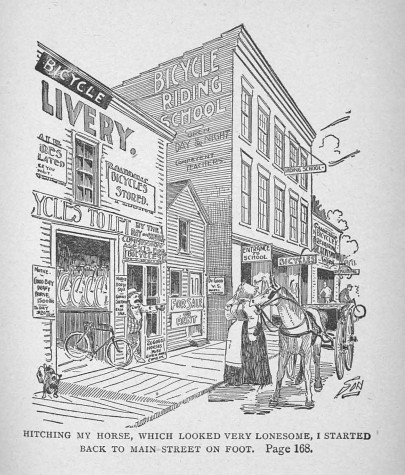


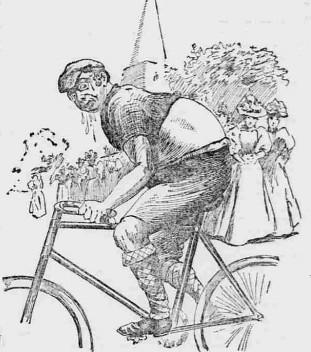
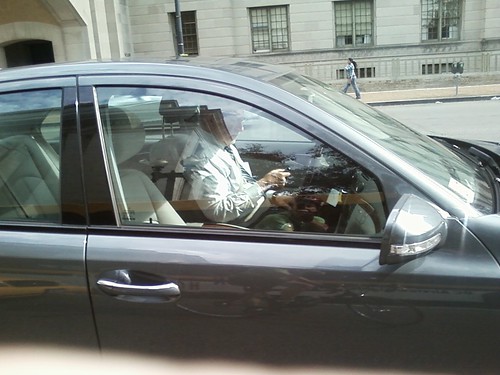
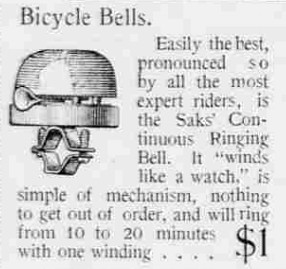
Bicycle Bells. Easily the best, pronounced by all the most expert riders, is the Saks' Continuous Ringing Bell. It "winds like a watch," is simple of mechanism, nothing to get out of order, and will ring from 10 to 20 minutes with one winding .... $1.
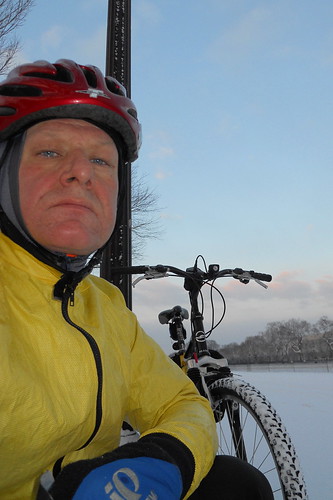

Why didn’t someone come up with this a long time ago?! Turn signals for bicyclists would be very useful and could go a long way towards reducing bicycle-vehicle collisions. From lifehacker: Unfortunately, few people know hand signals anymore, so Instructables user CTY1995 decided to make his…
 Bike Tribes: A Field Guide to North American Cyclists by Mike Magnuson
Bike Tribes: A Field Guide to North American Cyclists by Mike Magnuson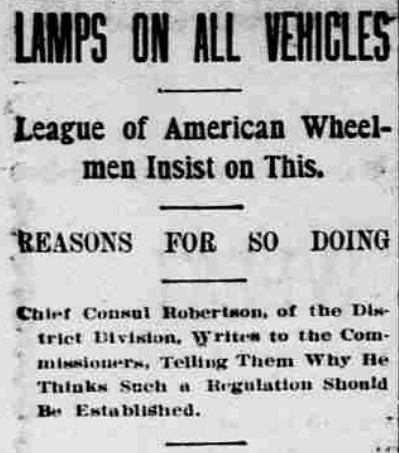
The District division of the League of American Wheelmen is still working for the interests of the bicycle rider.
In answer to a request from the Commissioners, Chief Consul Robertson yesterday mailed to them his reasons for thinking that all vehicles should carry lamps [at] night. The letter reads:
"August 29. 1896.
"Hon. Commissioners, District of Columbia.
"Gentlemen: In reply to your request that I should submit facts showing the necessity for all kinds of vehicles carrying lamps, I would respectfully submit the following reasons:
"Bicycles have been adjudged by the courts all ever the country as vehicles with equal rights on the streets and roads.
"Bicycles are required to carry lights. Private and business vehicles are not so restricted. According to this discrimination a bicycle for hire (which is a public vehicle) should be required to carry a light, but not the machine used as a private conveyance.
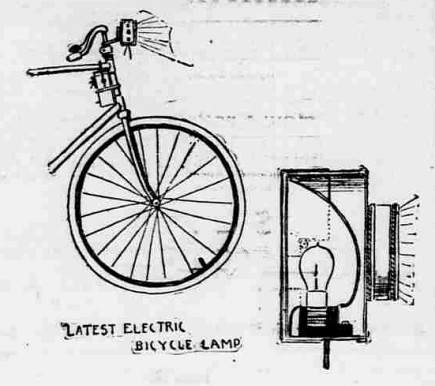
"A number of business houses require their drivers to carry a light within or about their vehicles, more for their own safely than for that of others. This can also be said of some of the owners of private carriages. At times it is very difficult to determine the direction in which a vehicle is traveling, or on which side ot the street it happens to lie, by the noise occasioned by the horses' feet. A light would show just what part of the street it occupies. One might advance the argument that if it were approaching it would be on the left hand side of the street, and on the right hand side if going in the same direction. This would be so if everyone obeyed the rules of the road, but unfortunately, this is not so, and more wagons are on the incorrect than on the correct side, else there would be less necessity for lamps on horse-propelled vehicles.
"A carriage or wagon is often collided with by both bicycles and other vehicles. This is especially the case when drawn up alongside of a curb awaiting the owner. In this instance the horse, not being in motion, no noise is made. A vehicle in this connection occupies the same relation to the street as a pile of mortar or bricks, and should be provided with a light. It is it temporary obstruction, and one is more liable to danger than if it were known to be there, like mortar or bricks.
"A cycler generally leaves his lamp lighted when stopping before a house, because he knows his machine is in danger
of collision if he does not take this precaution.
"Therefore, I would respectfully request that all vehicle, be required to carry lamps.
"Very respectfully,
"WM. T. ROBERTSON,
"Chief Consul D. C. Div. L. A. W [League of American Wheelmen]
Possible to Equip the Wheel Like a Ship - WINGS OF WHITE SILK
Connected to Bamboo Poles, the Sails Are Ran Up and Down as the Wind May Turn - They Make Wheel the Ideal Locomotion for a Sultry Day.
There is activity at the sailmakers, though this is the season when all sails should be finished and floating the blue horizon.
This unwanted activity is caused by the sudden appearance of the bicycle sail, out of which has sprung a demand for sails, unprecedented even in cup years. The bicycle sail is a little affair. It is made of duck or sailcloth, and its dimensions are a little more than a yard square.
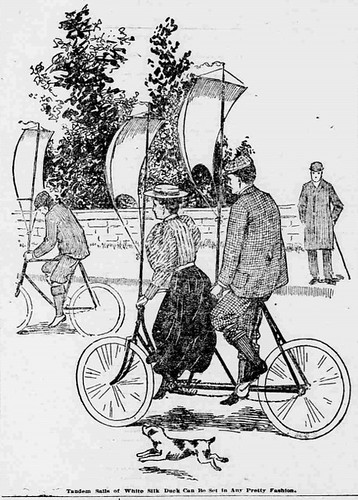
The cost of white sails for a bicycle comes to something like $3, if you are contented with a good quality and a fairly white sail. If you want the silk finish and the dazzling white, you must pay for it fully twice as much.This is not a perfect propulsion system, however.
HARD TO MANAGEAnother trend from the 1890s that met with some success in the press, but not in reality.
In rigging up a bicycle's sails there is a great deal of care necessary. A person not an expert, starting off swiftly upon a wheel rigged with sails of his own making, would undoubtedly get a fall of the most sensational description. His sails being raised too high would carry him along at a top-heavy pace and he would be unable to keep back his machine by back-pedalling, or any of the arts known to the wheelman. More than that, it would throw him forward upon his wrists in a frantic effort to keep his seat. And the result would be awkward, even if he escaped calamity.
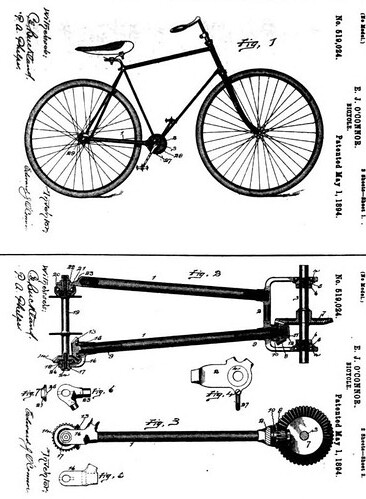
Diplomats Proficient Upon the Shining WheelLater in the article it is noted that at this time there was some modesty among cyclists ~
Russian and Austrian Ministers Are Expert Riders, and the Chinese Attaches, in Gay Costumes, Are Bicycle Devotees.
The bicycling craze has taken a strong hold on Washington society, and has extended into the diplomatic corps.
The foreigners have become greatly interested in the fad of the hour, and many of them are already proficient riders of the shining wheel.
The first to lend in this respect was the Russian minister, Prince Cantacuzene, who no sooner was able to keep his equilibrium upon the "bike" than he induced his daughter to become accomplished in the same manner. Every afternoon during last autumn, and almost every late afternoon during the winter, the Prince and Princess Cantacuzene might have been seen spinning over the miles of smooth asphalt in the city on their bicycles.
At first, of course, when the bicycles were brought out and placed in front of the legation they created no end of excitement in the neighborhood, and the dwellers along that particular square made a brave showing on the front porticos and at the windows to watch the mount and triumphal start.
Gradually, however, as tho novelty wore off, the prince and his young daughter, who were debarred from taking any active part in the season's gayeties on account of the fact that the Russian legation was in mourning for the death of the Czar, were allowed to depart upon their afternoon bicycling trip without this attendant notoriety.
As a matter or fact, the favorite place with the members of the diplomatic corps, and society generally who ride the bicycle, is the great open space back of the President's mansion, "Executive driveway," as it is sometimes called now, since the old name of "White Lot" has been abandoned by the fashionables.The Czar who died in 1895 was Alexander III, the father of Nicholas II, who was overthrown by the Bolsheviks in 1917. I hadn't realized, but his heir for a time was his brother, who was killed in a bicycle accident in 1899: "The death of Grand Duke George, Czarevitch of Russia . . . the hemorrhage which caused the death of the Czarevitch was the result of a fall from his bicycle which be sustained while on an excursion in the hilly country near Abbas Tuman. The paper adds that he died near the scene of the accident." (From another newspaper article.)
There the bicyclers congregate in large numbers all during the spring and autumn evenings directly after dark, for as yet the majority of society has no fancy for being stared at in daylight when bicycle riding.
.Russia's Tianamen image. twitter.com/ioffeinmoscow/…
— Julia Ioffe (@ioffeinmoscow) May 6, 2012
SUNDAY SPORT - Decoration Day Bicycle Meet at the Park
A VERY GOOD TURN OUT LARGE FIELD OF PROFESSIONALS AND A GOOD TIME
Balsden, the San Francisco Crack, Makes a Fine Exhibition of Trick and Fancy Riding
The Decoration day race meet yesterday attracted quite a large crowd to Agricultural park, and if the attendance was any criterion by which to form an opinion as to the popularity that may attend Sunday racing, then the program as outlined ln the future may be considered assured. . .




 Just Ride: A Radically Practical Guide to Riding Your Bike by Grant Petersen
Just Ride: A Radically Practical Guide to Riding Your Bike by Grant Petersen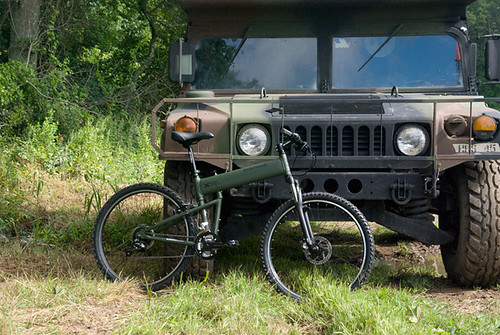
 The Enlightened Cyclist: Commuter Angst, Dangerous Drivers, and Other Obstacles on the Path to Two-Wheeled Trancendence by BikeSnobNYC
The Enlightened Cyclist: Commuter Angst, Dangerous Drivers, and Other Obstacles on the Path to Two-Wheeled Trancendence by BikeSnobNYC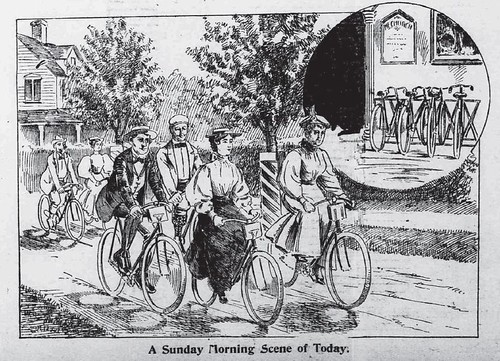
Concerned for the safety of bicyclists, Dumbarton United Methodist Church will hold a “blessing of the bicycles” for all riders on May 12, from 8:30 a.m. to 10 a.m. at Fletcher’s Cove, where two bike paths intersect (a spot along both the C&O Canal and the Capital Crescent bike trail). Pedalers on a Saturday morning outing will be able to take their bikes to a quiet setting ofMore details are available here.
trees and grass near Fletcher’s Boat House and receive a brief blessing from the church pastor, Rev. Mary Kay Totty.
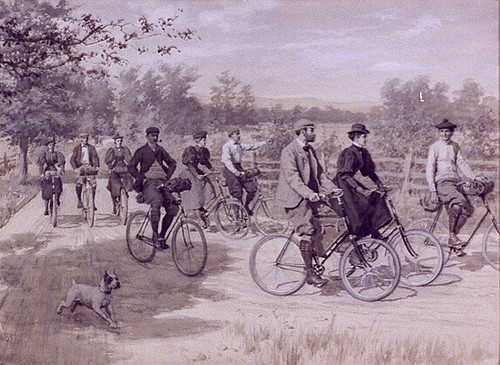
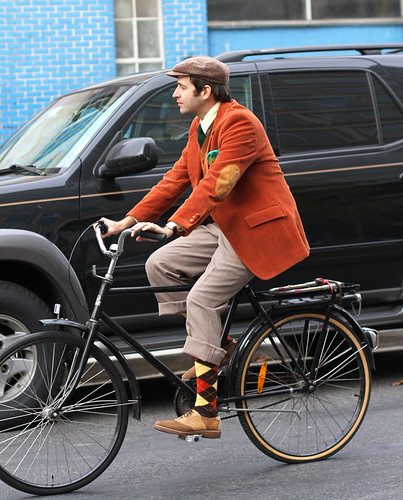
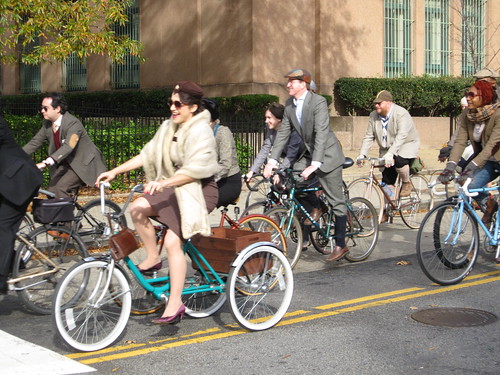
In learning to mount, head your wheel for the down grade, place your left foot on the little projection on the rear axle, shove off with the right foot, raise up on your left foot, and balance that way until the right pedal rises to its height, then place the right foot on it, glide into the saddle and seek the left pedal with the left foot. Experts are in the habit of mounting directly from the pedal as a horse is mounted. This requires considerable skill. Dismounting, however, is done from the pedal. Just as the pedal reaches it lowest level, and is about to rise, stand up on it and fling the other leg over the saddle. Mounting from the pedal is done in the same manner.Of course, this mounting from a peg on the left of the rear wheel is quite different than what is generally done today. One may wonder why they felt that "considerable skill" was required to mount the bicycle as we typically do today, and the answer would be that this is a fixed gear arrangement so that whenever the bike moves, the pedals spin - there is no coasting possible - and this would make getting on a moving bike with the left foot on the left (spinning) pedal more difficult, assuming you try to get moving and get on at the same time (which apparently was the thinking).
